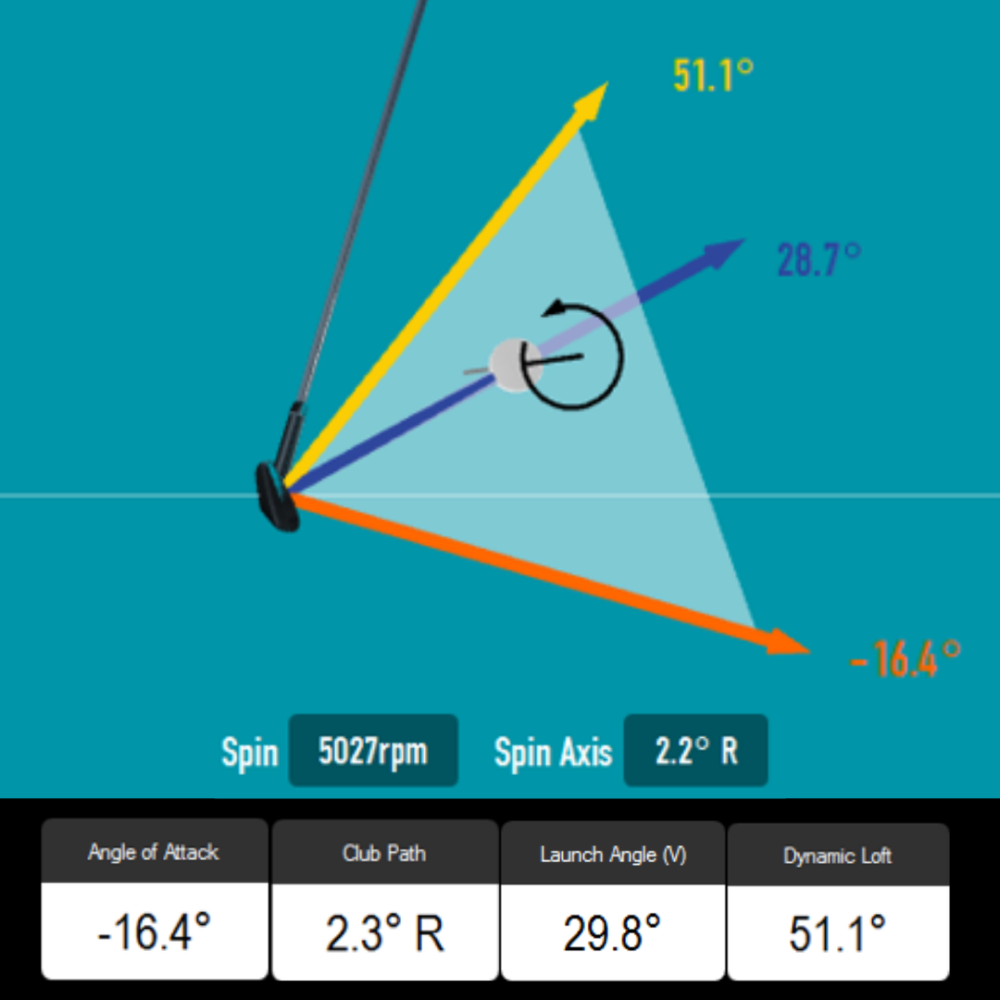Over the last two years I have collected wedge data on a specific golf shot. The partial wedge, pitch, or distance wedge as I refer to it. In this case a 50 yard golf shot. Over 200 unique data points were collected from players of varying skill levels, from beginner to playing professionals.
If anything I learned quite a bit about my own teaching in the process. Here I share the finding of this study and hope that you as a player or fellow coach can glean a little something as well. The parameters of collection were as follows:
- Launch monitor used, FlightScope X3
- Titleist Pro-V1’s
- Two different 10 shot sets from each player
- Player attempting to fly the ball 50 yards
- First 10 ball set was conducted using the players current sand wedge (54-56*)
- Conditions dry (easy to do, it really never rains here)
My overall goal with the study was not necessarily to find new groundbreaking information, but to:
- Confirm/ deny ideas I have studied
- Identify patterns of success and its opposite in the average golfer
Findings
- The better wedge players took little to no divot. Probably not new information to anyone that studies wedge play. However, I found no correlation between divot depth and Angle of Attack (AOA). As in I saw plenty of good wedge players take almost no divot with steep AOAs (-8 +) and with Shallow AOAs (-8 and below). The below images are from different players producing different spin, different spin axis, similar launch, and similar dynamic loft. However, in both of these players there was only a light grazing of grass. Even though there was over a 5* degree difference in AOA.

- Optimal technique appears to be player dependent and totally based on turf interaction and contact. As soon as the player made better contact with the ball (sometimes over a period of instruction) numbers always improved.
- With a solid strike lower trajectory wedges almost always had more spin than higher trajectory wedges. Anytime the ball was launched higher than 36* spin was almost always under 6300 range.
- For years now I have been adamant about hitting small draws with wedges. As in the ball reads with a left spin axis. I saw too many good wedge shots with right spin axis to maintain that thought. Case in point one of the better wedge players I have seen in person is shown in the above right picture. Steep AOA, with sizable right axis tilt (9.5). I can assure you that you would not want to play closest to the pin from 85 yards and in against him.
- The single greatest mechanical component I can see that contributes to quality contact vs. poor contact would be how much the grip elevates through the hitting area. The worst wedge players in terms of achieving quality contact were almost always dragging the grip through the hitting area, and to the right at that. Nothing with numbers to report there, but from an eye on ground perspective that is what I saw. The image below is of a left-handed player, (professional) the red lines are simply drawn on the grip through various frames. I would maintain that this is good image of what is described above.

- When a player’s intention was to hit a high U-shaped trajectory and land it at the 50-yard marker, it very rarely occurred. Lower trajectory players add more accuracy in terms of landing the ball close to their target. Take that as you want to.
- About Three-quarters of the way through the data collect
 ion I started to see a few interesting items pop up and in tracking what wedge and the condition that wedge was in, I began to notice a lot of obscurely high launch angles from players that had noticeably worn wedges. Particularly the area between the groves being worn and almost smooth in some cases. For the remainder of study, I had players hit balls with their wedge and then a brand-new Callaway MD4 wedge of the same loft equivalent. The results provided MAJOR difference in launch. Routinely taking players from launching it 41-34* to 28-34*. Which given everything stated above about trajectory. I would say is a sizable find. Guessing something to do with friction? But I am not sure. Long story short it may actually be the golf club. To some degree, so don’t quite go and wave this article around propositioning for new wedges.
ion I started to see a few interesting items pop up and in tracking what wedge and the condition that wedge was in, I began to notice a lot of obscurely high launch angles from players that had noticeably worn wedges. Particularly the area between the groves being worn and almost smooth in some cases. For the remainder of study, I had players hit balls with their wedge and then a brand-new Callaway MD4 wedge of the same loft equivalent. The results provided MAJOR difference in launch. Routinely taking players from launching it 41-34* to 28-34*. Which given everything stated above about trajectory. I would say is a sizable find. Guessing something to do with friction? But I am not sure. Long story short it may actually be the golf club. To some degree, so don’t quite go and wave this article around propositioning for new wedges.
- The 30* launch angle has long been held as the standard for “low” trajectory “high” spinning wedge. While technique certainly plays a roll in achieving contact. There are other factors involved in creating that 30* angle.
- Equipment – As discussed wedges matter, but so does ball. With a premium ball and new wedge, you wouldn’t believe some of the techniques that produced quality launch and spin numbers. A worn wedge and a range ball would make as much as much as 12* degree difference in launch. So, imagine practicing and seeing that window of launch and then trying to move it to the golf course.
- Ground Conditions – Our tee was mostly dry as we are in the Mojave Desert. We did have a few days of collection differed from the “normal day”
- Longer Grass – Right after our overseed period the tee is always a bit shaggy. Spin reduced as much 3500 rpms on a good strike. Material between the face and the ball, reducing friction I am guessing.
- It Rained once – We had a really wet January and February in 2019. I did catch one day where our tee was really wet. Spin reduced substantially and launch increased; no low spinners were hit that day.
- Sandy Tee- We had some struggles with our tee in the levelness of it. Our superintendent dumped a whole bunch of sand on it and leveled it out. (which worked) For about two weeks it had the appearance of really heavily top dressed green. I had three collection tests during that time and all produced inflated spin numbers. One is actually pictured above (12,000 + RPM) Again, going to default to friction, this time there was more. Would love to do more research here, limited sample pattern at this point.
Conclusion
To sum it up, my findings were different than I expected them to be. In full transparency I went into the study expecting to find a clear-cut attack angle, launch, and spin loft that would be ideal. However, at this time in looking at the data I cannot say that…really at all. Each golfer brings their own mix to the tee. Key takeaways for the average golfer:
- Get yourself making clean contact with the ball, and a nice wedge and everything else will take care of itself.
- Make technique changes solely by/for the purpose the quality of the turf interaction
- Do Not expect the same spin and launch in ranging conditions. Wet, dry, long grass, etc. because it won’t happen.
- Players intention matters, absolutely yes. In polling people while data collecting thought on what they perceived should occur almost always actually occurred. As in they thought they wanted to hit it really high, or thoughts on impact. Like hitting down on it harshly to “compress it.” Please do not do that… Intention matters, so clarify that with yourself.
- I saw six players who had quantifiable flinches when trying to hit wedge shots. So, essentially a yip. Each one had little to no body rotation and four of the six had the intention of keeping their head down. Please refrain from doing that by the way.
- The art of teaching is real, if you are struggling with contact find a qualified coach…they can help

